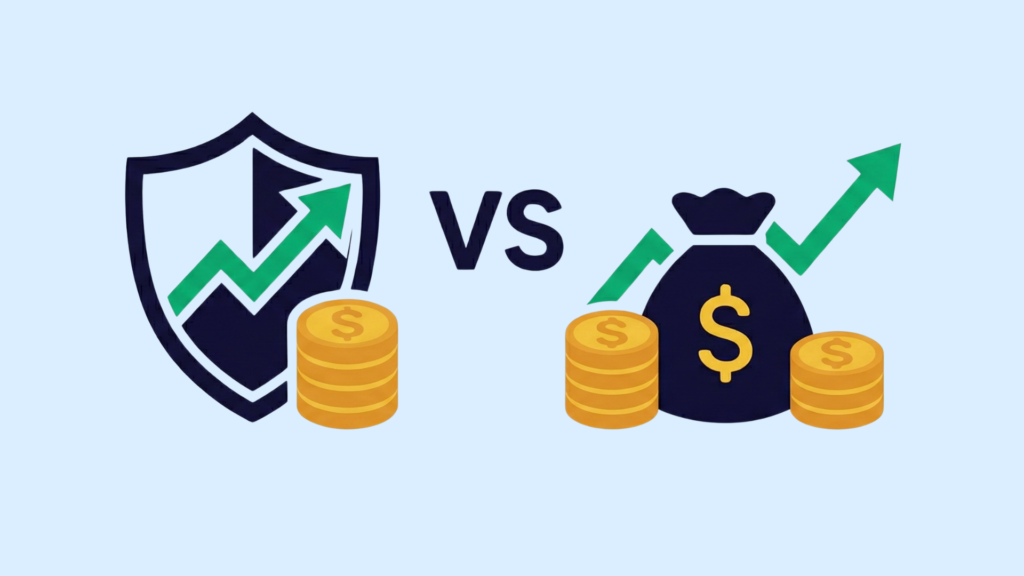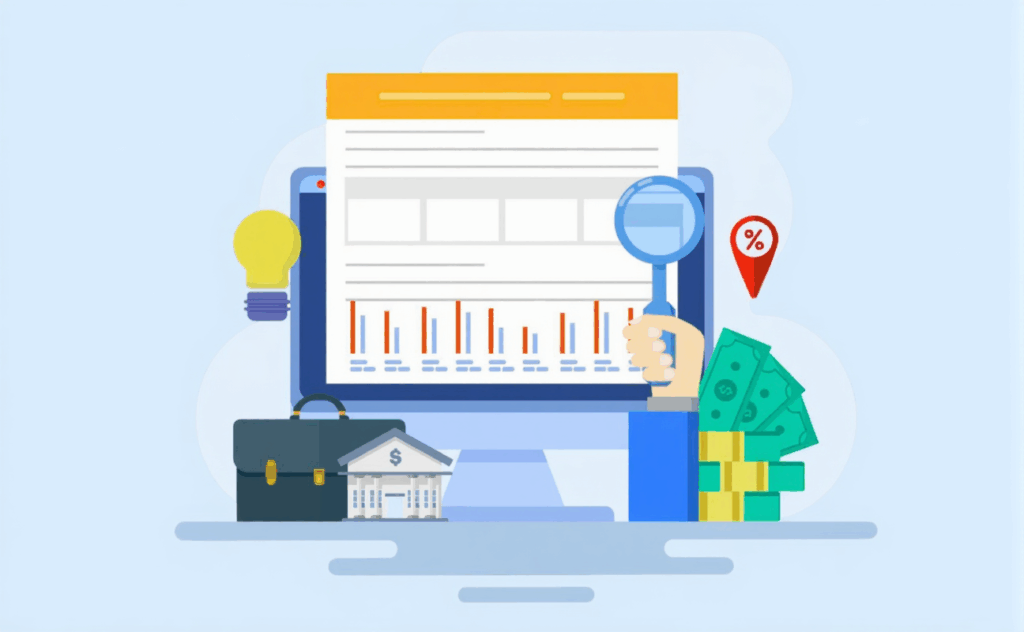Both ULIPs and mutual funds can help you build wealth, but they serve different purposes—one combines insurance and investment, while the other focuses purely on market growth. The challenge is knowing which fits your goals best.
In this blog, we’ll break down how to choose between ULIPs and mutual funds based on factors like returns, flexibility, risk, costs, and tax benefits.
Introduction to ULIPs and Mutual Funds
ULIPs and mutual funds are two popular investment options that help people grow their wealth while meeting various financial goals.
While both invest in market-linked instruments, their purpose and structure differ—ULIPs combine investment with insurance protection, whereas mutual funds focus solely on returns through diversified portfolios.
What is a ULIP?
A ULIP is a financial product that mixes life insurance coverage with market-linked investments. When you invest in a ULIP, some of the premium goes towards life insurance, and the rest of the amount gets invested in equity, debt, or hybrid funds—based on your chosen plan.
What Are Mutual Funds?
Mutual funds are pure investment vehicles that pool money from multiple investors to invest in a diversified portfolio of assets (stocks, bonds, and money market instruments). Each investor owns units of the mutual fund, which represent their share of the overall portfolio.
Key Differences Between ULIPs and Mutual Funds
While ULIPs and mutual funds both invest in market-linked instruments, they differ in structure, cost, flexibility, and overall purpose.
ULIP vs Mutual Fund: Investment Focus
A ULIP serves a dual purpose: it combines life insurance protection with investment in market-linked funds. Part of your premium pays for the insurance cover, and the remaining gets invested in equity, debt, or balanced funds.
Whereas mutual funds are pure investment products. They pool money from investors and allocate it across multiple portfolios such as equities, bonds, or hybrid funds.
Charges: ULIP vs MF
ULIPs have a complex cost structure because they combine insurance and investment. Common charges are premium allocation charges, policy administration fees, and fund management charges.
In contrast, mutual funds have a simpler, lower-cost structure, primarily an expense ratio that covers fund management and administrative expenses. There are no insurance or policy-related charges, and the costs are regulated by SEBI.
Flexibility and Liquidity
ULIPs come with a mandatory lock-in period of 5 years, which restricts withdrawals or switching during that time. After the lock-in, you can make part withdrawals or switch between equity and debt funds within the same policy.
Mutual funds, on the other hand, offer high liquidity—most funds allow investors to redeem units at any time at the current Net Asset Value (NAV). The only exceptions are ELSS that have a 3-year lock-in period.
Tax Implications of ULIPs and Mutual Funds
ULIPs offer insurance-linked tax benefits, while mutual funds are subject to capital gains taxation depending on the investment duration and fund type.
Tax Benefits of ULIPs
ULIPs provide tax advantages on both the premium paid and the maturity proceeds.
- Tax Deductions under Section 80C:
- Premiums paid toward ULIPs are eligible for a tax deduction up to ₹1.5 lakh per year under Section 80C of the Income Tax Act under the old tax regime.
- However, to qualify, the annual premium must not be more than 10% of the sum assured for policies that are issued after April 1, 2012.
- Tax-Free Maturity under Section 10(10D):
- The maturity amount, including bonuses, is tax-free under Section 10(10D), provided the premium-to-sum assured ratio conditions are met.
- In case the total annual premium across ULIPs (issued after February 1, 2021) exceeds ₹2.5 lakh, the maturity proceeds become taxable as capital gains.
Important Update (Budget 2025): ULIPs have been reclassified as capital assets. While policies with annual premiums below ₹2.5 lakh generally remain tax-free under Section 10(10D), if the premium exceeds 10% of the sum assured (even if below ₹2.5 lakh), the maturity amount may be taxed as capital gains. Consult a tax advisor for specific guidance on your policy.
Taxation on Mutual Funds
Mutual funds do not offer upfront tax deductions (except for ELSS funds), but they can still be tax-efficient based on how long you hold the investment and the type of fund.
- Equity Mutual Funds:
- Equity Mutual Funds STCG: Taxed at 20% if held for 12 months or less
- Equity Mutual Funds LTCG: Taxed at 12.5% on gains exceeding ₹1.25 lakh per financial year
- Debt Mutual Funds: From April 1, 2023, all debt mutual funds are taxed based on the investor’s income tax slab, irrespective of the holding period.
- ELSS (Equity Linked Savings Scheme): Investments qualify for a tax deduction up to ₹1.5 lakh under Section 80C under old tax regime.
- Dividend/IDCW Taxation: Any dividend received (under the IDCW option) is taxed as per your income slab, and TDS applies if annual payouts exceed ₹5,000.
Risk Factors in ULIPs and Mutual Funds
Both ULIPs and mutual funds are market-linked investments, which means they come with varying degrees of risk. The difference is in how the risks are managed.
Risk in ULIPs
Key risk factors in ULIPs:
- Market Risk: ULIP returns fluctuate with market movements, as investments are tied to market instruments such as equities and bonds. Equity-oriented ULIPs carry higher risk but also higher return potential, while debt ULIPs are relatively stable.
- Insurance Component and Charges: ULIPs have several charges, such as mortality charges, fund management fees, and policy administration costs.
- Lock-in Period: ULIPs have a mandatory 5-year lock-in, which limits liquidity and prevents investors from exiting early during volatile markets.
Risk in Mutual Funds
Key risk factors in mutual funds:
- Market Volatility: Equity mutual funds are sensitive to market movements—they can deliver high returns over time, but are risky in the short term. Debt funds (while more stable) can face interest rate risk or credit risk if borrowers default.
- Fund Type Risk:
- Equity Funds: High-risk and suitable for long-term investors.
- Debt Funds: Moderate risk and suited for stability and income.
- Hybrid Funds: Balanced risk and ideal for moderate investors.
- No Insurance Cushion: Investors must rely only on market returns for growth since mutual funds don’t offer life coverage.
When to Choose ULIPs Over Mutual Funds
ULIPs are best suited for investors who want to combine life insurance protection with long-term investment growth.
Benefits of Choosing ULIPs
- Dual Benefit of Insurance and Investment: ULIPs provide life insurance coverage along with investment options across equity, debt, or hybrid funds, offering both protection and wealth creation under one plan.
- Tax Advantages: ULIP premiums qualify for tax deductions under Section 80C, and maturity proceeds may be tax-free under Section 10(10D) if you have opted for old tax regime.
- Long-Term Discipline: With a 5-year lock-in period, ULIPs encourage investors to stay invested for the long term which helps in accumulating wealth steadily over time.
When to Choose Mutual Funds Over ULIPs
Mutual funds are best for investors focused on returns, flexibility, and lower costs, without bundled life insurance.
Benefits of Choosing Mutual Funds
- Lower Costs: Mutual funds typically have lower expense ratios than ULIPs as they don’t include insurance-related charges.
- Higher Liquidity: Most mutual funds (except ELSS) have no lock-in period, allowing investors to redeem units anytime they need funds.
- Wide Range of Options: Investors can choose from equity, debt, hybrid, or index funds based on their risk tolerance and financial goals.
Which is Better: ULIP or Mutual Funds?
Choosing a ULIP and a mutual fund depends on your financial goals, risk tolerance, and investment goals. Both have their strengths, but they serve very different purposes.
- Choose a ULIP if you want a combination of life insurance and investment, prefer long-term disciplined investing, and value tax benefits under Sections 80C and 10(10D) (available only under the old tax regime). It’s a good fit for investors focused on goal-based planning, such as retirement or family protection.
- Choose a Mutual Fund if your goal is wealth creation, flexibility, and lower costs. Mutual funds suit investors who want to maximise returns, enjoy liquidity, and have the freedom to switch between different funds or asset classes as market conditions change.
Frequently Asked Questions (FAQs)
Are ULIPs more expensive than mutual funds?
Yes, ULIPs are generally more expensive than mutual funds as they include insurance charges, fund management fees, and policy administration costs. Whereas, mutual funds charge a fund management fee—which makes them more cost-effective for pure investment purposes.
Can I switch my investments between different funds in ULIPs and mutual funds?
ULIPs offer internal fund flexibility, while mutual funds give you broader external choice across multiple fund houses.
- ULIPs: Allow free or limited fund switches between equity, debt, or balanced options within the same policy, helping you adjust your portfolio based on market conditions.
- Mutual Funds: Require you to redeem and reinvest if you wish to move between different schemes or fund types, which may attract tax implications and exit loads.
What is the lock-in period for ULIPs and mutual funds?
ULIPs tie up your funds longer, whereas mutual funds offer better liquidity and shorter or no lock-ins.
- ULIPs: Have a lock-in period of 5 years, during which you cannot withdraw your investment.
- Mutual Funds: Only ELSS (Equity Linked Savings Schemes) have a 3-year lock-in, while most other mutual funds allow withdrawals anytime.
Are ULIPs suitable for everyone?
Not necessarily. ULIPs are best for investors who:
- Want a combination of insurance and investment,
- Can commit to long-term investing (5+ years), and
- Are comfortable with higher charges and limited liquidity.
What happens if I miss a premium payment for my ULIP?
If you miss a premium payment during the lock-in period:
- The ULIP may enter a grace period (usually 15–30 days), during which you can still pay without penalty.
- If not paid, the policy moves to a discontinued fund, where your money earns a lower return until you revive or withdraw after 5 years.
Disclaimer
The information provided in this article is for educational and informational purposes only. It should not be considered as financial or investment advice. Investing in stocks involves risk, and it is important to conduct your research and consult with a qualified financial advisor before making any investment decisions. The author and publisher are not responsible for any financial losses or gains that may result from the use of this information.























